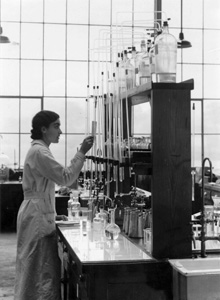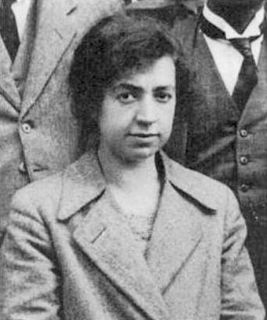
Percy Faraday Frankland CBE FRS was a British chemist.

Grace Coleridge Frankland known as Mrs Percy Franklandnée Grace Toynbee was an English microbiologist. She was one of the nineteen female scientists who wrote the 1904 petition to the Chemical Society to request that they should create some female fellows of the society.

Lilian Mary Faithfull CBE was an English teacher, headmistress, women's rights advocate, magistrate, social worker, and humanitarian. She was one of the "Steamboat ladies" who were part of the struggle for women to gain university education.

Edith Ellen Humphrey was a British inorganic chemist who carried out pioneering work in co-ordination chemistry at the University of Zurich under Alfred Werner. She is thought to be the first British woman to obtain a doctorate in chemistry.

May Sybil Leslie was an English chemist who worked with Marie Curie and Ernest Rutherford. From 1920 until her death Leslie was a Fellow of the Royal Society of Chemistry.
Millicent Taylor was a British educator and chemist who worked in the fields of organic chemistry and physical chemistry.

Sibyl Taite Widdows (1876–1960) was a British Scientist and member of the Chemistry department at the London School of Medicine for Women for 40 years.
Mildred May Gostling, also published under her married name Mildred Mills, was an English chemist who completed research in carbohydrate chemistry. She was one of the nineteen signatories on a letter from professional female chemists to the Chemical Society requesting that women be accepted as Fellows to the Society.
Mary Beatrice Thomas was a lecturer in chemistry at Royal Holloway College and later at Girton College, Cambridge where she was also Director of Studies. She was a noted educator, co-editing a chemistry textbook written by Ida Freund, as well as being one of the nineteen signatories to a petition to the Chemical Society arguing for admission of women as Fellows of the Society.
Katherine Isabella Williams was a British woman chemist who became a student, aged 29, at University College Bristol. She was known for her collaboration in the 1880s with Nobel prize winning Scottish chemist, William Ramsay and was also one of the signatories of the 1904 petition for the admission of women to the Chemical Society.
Dorothy Blanche Louisa Marshall was a British chemist who worked at Girton, Avery Hill and the National Physical Laboratory. In 1904, she signed a petition for women to be admitted as a Fellow of the Chemical Society.
The 1904 petitionto the Chemical Society was a petition written by 19 female chemists setting out the reasons why they should be afforded the status of Fellow of the Chemical Society. The petition is of importance as it eventually led to the admission of women as Fellows of the Society, as well as identifying prominent female chemists working in Britain at this time.
Hilda Jane Hartle was a British chemist researcher and teacher. She was prominent in promoting the teaching of Chemistry to women and became known for her opposition to domestic science.
Clare de Brereton Evans was a scientist and academic who became the first woman to be awarded a doctorate in Chemistry (DSc). She was a pioneer translator of Meister Eckhart's German works.

Elizabeth Eleanor Field was a British chemist and the Head of Chemistry at Royal Holloway College for over nineteen years. She is also noted as one of the nineteen signatories of the 1904 petition which aimed to grant women the status of Fellows of the Chemical Society.
Katherine Alice Burke was a British chemist and one of the nineteen signatories of the 1904 petition to the Chemical Society.
Alice Emily Smith was a British chemist and one of the nineteen signatories of the 1904 petition to the Chemical Society.
Margaret Douie Dougal was a British chemical publication indexer for fifteen years (1885-1909) for the Chemical Society. Dougal contributed to the compilation of volumes i-iii of A Collective Index of the Transactions, Proceedings and Abstracts of the Chemical Society. The then president of the Chemical society, Sir James Dewar, congratulated Dougal for her work as "an example of thoroughness and accuracy to her successors." The collected decennial indices were also prepared by Dougal; at the 1906 Annual Meeting of the Chemical Society it was noted that the Council "had pleasure in expressing the high appreciation of the ceaseless energy displayed by the indexer, Mrs. Margaret Dougal, on the completion of this valuable work."
Dr Janette 'Ettie' Stewart Steele was a British chemist. She submitted the first PhD thesis at the University of St Andrews and worked there for the rest of her career in several roles including University Assistant, Lecturer, Warden of the women's students residence, and secretary to Principal James Irvine.
Mary Watson was a British chemist. She was one of the first two women to study Chemistry at the University of Oxford, the other one being Margaret Seward.







